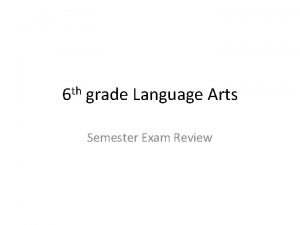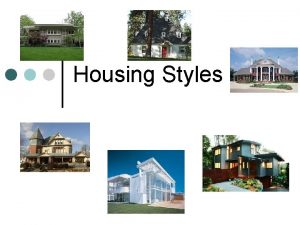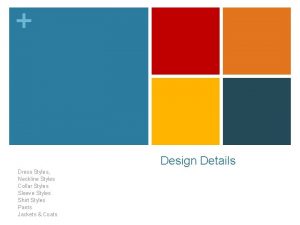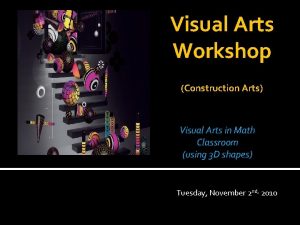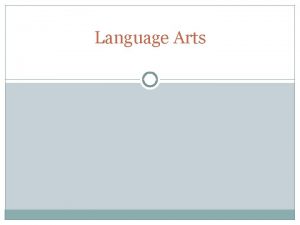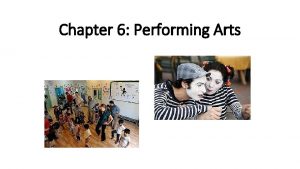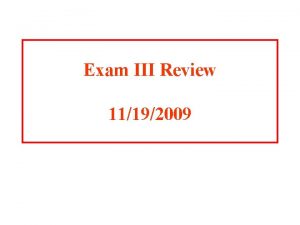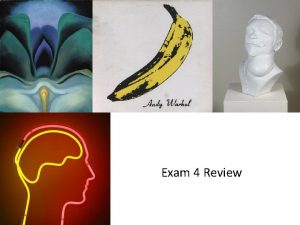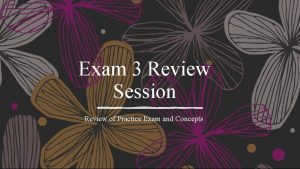Exam Review Grade 10 History Arts Styles have


































- Slides: 34

Exam Review Grade 10 History

Arts Styles have produced in class • Illuminated Manuscripts • Stain glass- rose windows • Mosaics

Manuscript…. • manus a Latin word meaning HAND • scriptus a Latin word meaning TO WRITE

Illumination. . . • Part of the manuscript that reflects light, • specifically, ”the Light of God”

History • Prior to the invention of the printing press, books had to be made by hand. • These manuscripts were produced by skilled craftsman; the scribe calligraphed the test and various artists decorated the manuscript. • Illuminators, had varied social status. Most were humble craftsmen but the best held the rank of court artists (protectors).

“Age of Faith” • During the Middle Ages owning a manuscript was considered a status symbol, wealthy • It also helped spread Christianity by giving uniformed information • Most books were Bibles, Psalters, Books of Hours and Breviaries

Pictures of the World 14 th Century

Patrons of the arts…. • One example of a “protector” of the arts is John of France, duke of Berry • A lover of luxury, he amassed a great collection of art and manuscripts, including; “Petites Heures”, “Belles Heures” and “Tres Riches Heures”

Insular Art • Example: The Book of Kells is a copy of the four Gospels in Latin. • interlaced shapes and ornamental details

Illuminated letter & Border

Picture • It should be colouful and unique • It can be separate from the text or imbedded in the text • Used for telling the story as not everyone could read

Calligraphy • Should have words done in calligraphy • Was done by priest

Mosaics Defined • A mosaic is a form of decorative art, in which small tiles-the materials commonly used are marble or other stone, glass, pottery (known as tesserae, diminutive tessellae), mirror or foilbacked glass, or shells, are used to create a pattern or picture. • It was used in ancient times for domestic interior decoration, • In the middle ages in churches (religious scenes)

• Byzantine art • In the Middle Ages it was found in churches • used for learning and for propaganda, • The rulers would often put themselves in the work to show their dedication to God • symbolizes the might of Christian rule within the Roman empire Theodoric, Ravenna, city of mosaic: 5 th - 6 th century AD

Islamic Mosaics

Today • You can see mosaics in homes as backsplashes, floors or decorative art. • You will also see them in government buildings on the floors or walls

Stained Glass Windows • Mural paintings were gradually replaced in favor of stain glass. • New Gothic Architectural style which allowed for large stained glass windows in the Cathedrals

• Colored glass would be cut by a hot iron. • Then details would be painted on the glass with black enamel paint. • The glass would be heated to bake the enamel onto the glass. • The pieces would then be put together with a strip of lead to hold the glass pieces together.

An early 15 th-century roundel of Reynard the Fox. • In the early MA the only colours available in the were saffron-yellow, purplish-red, green, blue and copper-red. • After 1300 silver solder/flux? (Silberlot) was also available, which allowed for a new range of colours, for example light yellow and reddish-yellow. The colours were melted onto the glass. The Virgin Annunciate c. 1340

• The illustrated manuscripts provided the design ideas for many of the windows. • Many of the windows were in 12 large sections which may have represented the 12 apostles.

Since most people could not read, the use of stained glass windows did more than add light and beauty. The church used them as an effective way to teach people about religion.

Today you can see stain glass windows in churches, homes and important public buildings like libraries and government buildings • Rose Window, National Cathedral, Washington D. C

Art Styles in the Middle Ages • • Early Christian Pre-Romanesque Byzantine Gothic Celtic Islamic

Romanesque Architectural Style e Rounded Arches. e Barrel vaults. e Thick walls. e Darker, simplistic interiors. e Small windows, usually at the top of the wall.

Byzantine Architectural Style • Dome on 4 piers • Decorative interiormosaics and frescoes • covered porch (narthex) • nave typically has three aisles with the dome above the central square space • Thick walls • Small windows

Gothic Architectural Style e Pointed arches. e High, narrow vaults. e Thinner walls. e Flying buttresses. e Elaborate, ornate, airier interiors. e Stained-glass windows. “Flying” Buttresses

• The MIDDLE AGES was once called Medieval, Dark Ages and Age of Faith. • The Middle Ages spanned over thousands of years. It basically could be divided into three periods, the Early Middle Ages(4501000), the High M. A. (1000 -1200) and the Late Middle Ages. (1200 -1500) • Approximately 450 - 1400

Lifestyle • During the Middle Ages the main form of rule was the “feudal system” • Communities formed around a keep or a castle were the nobles would protect them in exchange for work • Peasants were owned by the Nobles • Nobles sometimes owned more than one land so they had vessels to run some of their castles (they would be lower nobles)

Home • They common people lived in one room homes that were cold and dark • The rich had homes much like today, richly decorated with tiled floors, tapestries, etc • The women were responsible for the home • They ate natural foods (serfs mostly vegetables rarely meat)

Careers • First sons inherited, but other sons could become priests, or trades or mercenaries • Women ran the homes, joined the church very few had jobs outside the home • Medicine, teaching and legal matters were done mostly by the priest or nuns • Late middle ages saw the emergence of trade and industry

Religion • The church was very powerful during the Middle Ages • They had land, money and power (often advising the king) • Bishops were from rich families • The priest and nuns had parishes or monasteries were they could educate or heal the people • They often took vows of poverty

High Middle Ages • • • Norman Invasion Crusades Magna Carta Castle building Cathedrals Beginning of towns

Knights • Sons of nobles began training at an early age for knighthood – Page – at 7 they were sent to another lord to be trained – Squire – at 14 they act as a servant to a knight – Knight- at 21 they become a knight and gain experience in local wars and tournaments

Late Middle Ages • As commerce grew, towns and cities grew • The Feudal system was lost to powerful merchant class • Beginning of the British Parliament (1400) • Overcrowding led to diseases and plague • Learning became less religious and more secular • Printing press developed • Catholic church losing power
 Creative arts grade 8 term 4
Creative arts grade 8 term 4 Writ of certiorari ap gov example
Writ of certiorari ap gov example World history spring final exam review answers
World history spring final exam review answers World history semester 2 review
World history semester 2 review Us history final semester 2 review
Us history final semester 2 review Fall semester exam review us history
Fall semester exam review us history Ap world history jeopardy review game
Ap world history jeopardy review game Dynanotes
Dynanotes Us history staar review kahoot
Us history staar review kahoot Creative arts grade 6 term 2
Creative arts grade 6 term 2 12 edges and 6 faces
12 edges and 6 faces Exam review template
Exam review template Spanish 2 review
Spanish 2 review Spanish packet answers
Spanish packet answers Human body systems final exam
Human body systems final exam Poe final exam review
Poe final exam review Mrcgp online questions
Mrcgp online questions Ied final exam
Ied final exam Hbs end of course exam review
Hbs end of course exam review Entrepreneurship 1 final exam review
Entrepreneurship 1 final exam review Spanish 2 final exam review answer key
Spanish 2 final exam review answer key Environmental science defination
Environmental science defination Apes ap exam review
Apes ap exam review English 4 semester 2 exam
English 4 semester 2 exam Review for exam pronouns
Review for exam pronouns Physics fall final exam review
Physics fall final exam review Zoology semester 1 exam review answers
Zoology semester 1 exam review answers Eduqas online exam review
Eduqas online exam review Physics fall semester exam review
Physics fall semester exam review English 3 fall semester exam review
English 3 fall semester exam review Sph3u exam review
Sph3u exam review English 3 fall semester exam review
English 3 fall semester exam review Chemistry semester 1 exam study guide answers
Chemistry semester 1 exam study guide answers Physics 1 exam 2 review
Physics 1 exam 2 review Physics exam 2 review
Physics exam 2 review





























